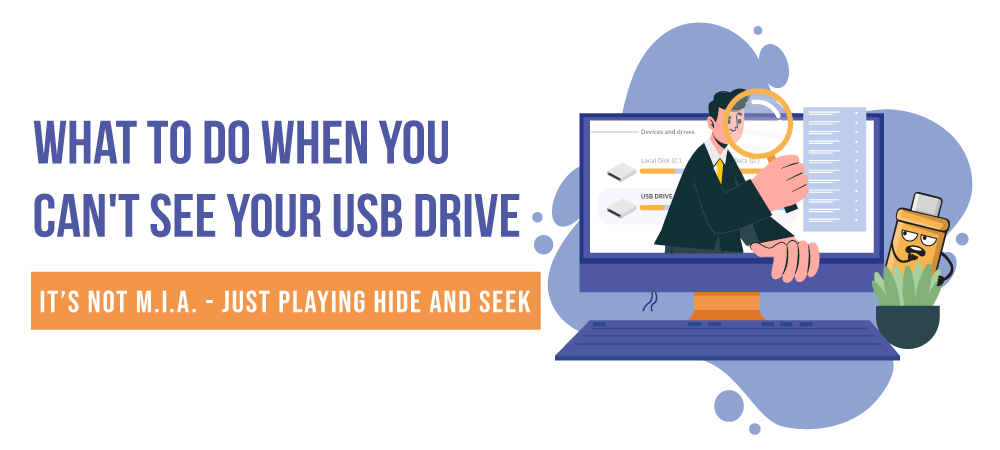
What to Do When You Can't See Your USB Drive
An invisible USB drive might sound pretty cool, in theory. (Maybe we'll try our hand at making one someday!) But if you've ever plugged a USB drive into a computer and been unable to find it, you'll know that a drive that your computer can't see is nothing but a headache.
If you're having trouble viewing your USB flash drive when it's plugged into your computer, this guide is for you. We'll talk about some simple things you can do to troubleshoot the problem and figure out what's wrong.

- Make sure you're looking in the right place on your computer.
On a Mac, your flash drive should appear in the Finder app in the left-hand sidebar under Locations. It will also show up as an icon on your desktop, so check there, too. If it's not showing up, go to Finder > Preferences > General and make sure that the "External Disks" box is checked.
PC users should look in File Explorer, also on the left-hand side menu. You should see the drive name and its volume letter appear under "This PC" near your other storage volumes.
2. Reboot and update and then reinsert the flash drive.
A reboot can fix all kinds of miscellaneous problems, including missing flash drives. If you're sure that you don't see your USB drive mounted anywhere on your computer, try simply rebooting it and looking for your drive again.
If you get the familiar prompt to install updates when you reboot your machine, do it! An out-of-date OS can have unexpected effects on all kinds of things, including storage devices. Thus, make sure that your installation of Windows or Mac OS is current with the latest patches and updates.
You should also try ejecting the flash drive, removing the connector from the USB port and reinserting it. Finally, now is a good time to check the drive itself to see if it includes any kind of switch. Some older flash drives need to be switched on to work.
3. Look for the drive in your OS's disk management utility.
Both Windows and Mac have disk manager applications that let users examine the properties of storage devices. Go to Disk Management in Windows or Disk Utility in Mac and see if your drive is showing up.
Unfortunately, if you can't see the drive at all in your disk management utility, there's a good chance that it simply needs to be replaced. If your drive does pop up, you'll be able to view key information such as your flash drive size and the file system it's formatted in.
You'll find some handy troubleshooting tools in the disk management utility as well. In Windows Disk Management, be sure to check whether your drive needs a new volume letter. Mac Disk Utility, meanwhile, includes a feature called First Aid that scans your drive for errors and gives you tools to correct them automatically.
Explore Our Full Selection of Bulk Flash Drive

4. Test the flash drive and the USB port.
Remove your USB drive and try inserting a different flash drive (or even a different USB device) into the same port. Next, try the same USB drive on a different computer. If you had your flash drive plugged into a USB hub, try plugging it directly into the computer instead.
If the drive doesn't show up on any computer, it likely means it's a problem with the flash drive. That might mean it's gone bad or it might need to be reformatted. On the other hand, if the drive shows up on the new device, your USB port may be the problem. Finally, if your drive shows up only on Windows or only on Mac, you might be dealing with a working drive that's simply in an incompatible format.
5. Find out if your drive is formatted with a file system your OS can read.
If you can see the drive in your disk utility, check whether its USB file system is compatible with your OS. For example, NTFS is Windows-exclusive, while APFS is Mac-exclusive. (This is a great time to point out that knowing about USB file systems is really important. You don't want to hand out your sleek-looking USB cards at a conference, only to find that half of your potential customers can't use them!)
If your drive isn't in a compatible format, you'll need to reformat it to a file system that your OS can read. That could be either a format specific to your system, or an OS-neutral one like FAT32 or exFAT. We cover how to do that in our USB reformatting guides for Windows 10 and for Mac. Proceed with caution, however, as this process will delete whatever is currently on your drive!
Use USB Cards for an Unforgettable Business Promotion

In search of high quality USB flash drives that won't fail you when it counts the most? We've got them at USB Memory Direct and we can customize them any way you'd like! Get a quote on your custom flash drives today. Or, check out our guides to common data storage-related questions, like "What is flash memory?"